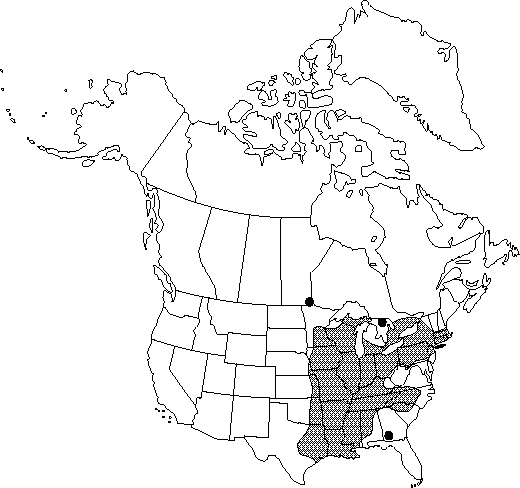Difference between revisions of "Ranunculus fascicularis"
Fl. Boston., 137. 1814.
FNA>Volume Importer |
FNA>Volume Importer |
||
| Line 16: | Line 16: | ||
|basionyms= | |basionyms= | ||
|synonyms={{Treatment/ID/Synonym | |synonyms={{Treatment/ID/Synonym | ||
| − | |name= | + | |name=Ranunculus fascicularis var. apricus |
|authority=(Greene) Fernald | |authority=(Greene) Fernald | ||
}} | }} | ||
| Line 33: | Line 33: | ||
|elevation=0-300 m | |elevation=0-300 m | ||
|distribution=Man.;Ont.;Ala.;Ark.;Conn.;Ga.;Ill.;Ind.;Iowa;Kans.;Ky.;La.;Md.;Mass.;Mich.;Minn.;Miss.;Mo.;Nebr.;N.J.;N.Y.;N.C.;Ohio;Okla.;Pa.;R.I.;S.C.;Tenn.;Tex.;Vt.;Va.;Wis. | |distribution=Man.;Ont.;Ala.;Ark.;Conn.;Ga.;Ill.;Ind.;Iowa;Kans.;Ky.;La.;Md.;Mass.;Mich.;Minn.;Miss.;Mo.;Nebr.;N.J.;N.Y.;N.C.;Ohio;Okla.;Pa.;R.I.;S.C.;Tenn.;Tex.;Vt.;Va.;Wis. | ||
| − | |discussion=<p>Ranunculus fascicularis is very similar to R. hispidus var. hispidus, and herbarium specimens without underground parts may be difficult to identify. Ranunculus fascicularis grows in drier habitats; segments of its leaves are commonly oblanceolate and blunt, with few or no marginal teeth; and its petals are widest at or below the middle. Ranunculus hispidus var. hispidus is usually larger in all its parts (leaves, flowers, heads of achenes); leaf segments are variable in shape but their apices are normally sharper and their marginal teeth more numerous, and petals are widest above the middle.</p> | + | |discussion=<p><i>Ranunculus fascicularis</i> is very similar to <i>R. hispidus </i>var.<i> hispidus</i>, and herbarium specimens without underground parts may be difficult to identify. <i>Ranunculus fascicularis</i> grows in drier habitats; segments of its leaves are commonly oblanceolate and blunt, with few or no marginal teeth; and its petals are widest at or below the middle. <i>Ranunculus hispidus </i>var.<i> hispidus</i> is usually larger in all its parts (leaves, flowers, heads of achenes); leaf segments are variable in shape but their apices are normally sharper and their marginal teeth more numerous, and petals are widest above the middle.</p> |
|tables= | |tables= | ||
|references= | |references= | ||
| Line 46: | Line 46: | ||
|rank=species | |rank=species | ||
|parent rank=section | |parent rank=section | ||
| − | |synonyms= | + | |synonyms=Ranunculus fascicularis var. apricus |
|basionyms= | |basionyms= | ||
|family=Ranunculaceae | |family=Ranunculaceae | ||
| Line 57: | Line 57: | ||
|publication year=1814 | |publication year=1814 | ||
|special status=Endemic;Weedy | |special status=Endemic;Weedy | ||
| − | |source xml=https://jpend@bitbucket.org/aafc-mbb/fna-data-curation.git/src/ | + | |source xml=https://jpend@bitbucket.org/aafc-mbb/fna-data-curation.git/src/8f726806613d60c220dc4493de13607dd3150896/coarse_grained_fna_xml/V3/V3_949.xml |
|genus=Ranunculus | |genus=Ranunculus | ||
|subgenus=Ranunculus subg. Ranunculus | |subgenus=Ranunculus subg. Ranunculus | ||
Revision as of 17:21, 18 September 2019
Stems erect or ascending, never rooting nodally, strigose or spreading-strigose, base not bulbous. Roots always both filiform and tuberous on same stem. Basal leaf blades ovate to broadly ovate in outline, 3-5-foliolate, 2.1-4.7 × 1.9-4.5 cm, leaflets undivided or 1×-lobed or -parted, ultimate segments oblanceolate or obovate, margins entire or with few teeth, apex rounded-acute to rounded-obtuse. Flowers: receptacle hispid or glabrous; sepals spreading or sometimes reflexed from base, 5-7 × 2-3 mm, hispid or glabrous; petals 5(-7), yellow, 8-14 × 3-6 mm. Heads of achenes globose or ovoid, 5-9 × 5-8 mm; achenes 2-2.8 × 1.8-2.2 mm, glabrous, margin forming narrow rib 0.1-0.2 mm wide; beak persistent, filiform, straight, 1.2-2.8 mm. 2n = 32.
Phenology: Flowering winter–spring (Jan–Jun).
Habitat: Grassland or deciduous forest
Elevation: 0-300 m
Distribution

Man., Ont., Ala., Ark., Conn., Ga., Ill., Ind., Iowa, Kans., Ky., La., Md., Mass., Mich., Minn., Miss., Mo., Nebr., N.J., N.Y., N.C., Ohio, Okla., Pa., R.I., S.C., Tenn., Tex., Vt., Va., Wis.
Discussion
Ranunculus fascicularis is very similar to R. hispidus var. hispidus, and herbarium specimens without underground parts may be difficult to identify. Ranunculus fascicularis grows in drier habitats; segments of its leaves are commonly oblanceolate and blunt, with few or no marginal teeth; and its petals are widest at or below the middle. Ranunculus hispidus var. hispidus is usually larger in all its parts (leaves, flowers, heads of achenes); leaf segments are variable in shape but their apices are normally sharper and their marginal teeth more numerous, and petals are widest above the middle.
Selected References
None.